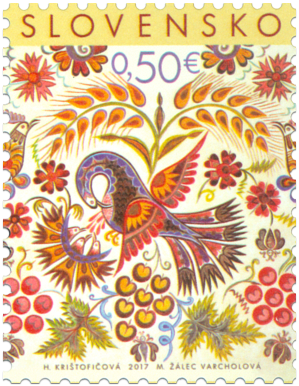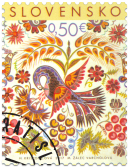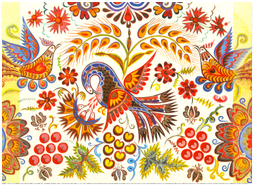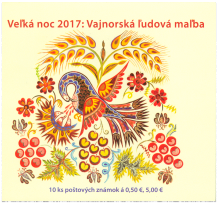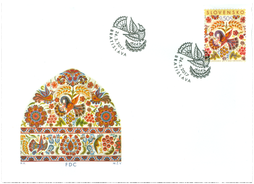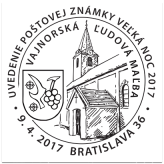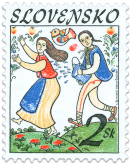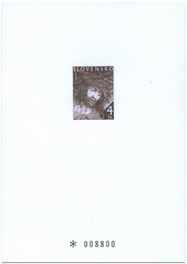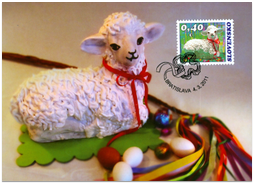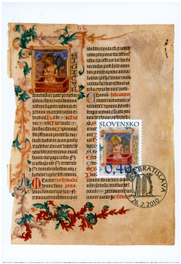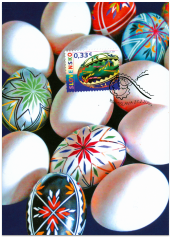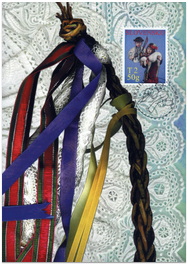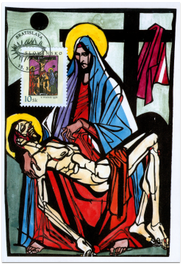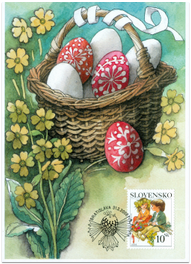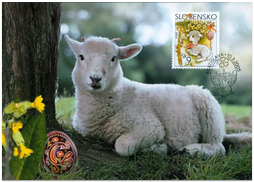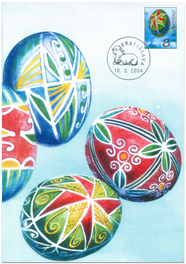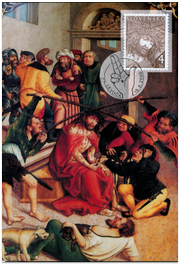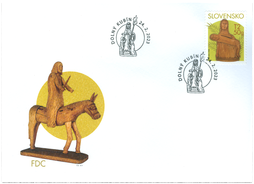632 Date of issue
24.03.2017 Face value
0.50 € Sell price
0.50 €
Perhaps surprisingly, the Easter issue is inspired by uncommon motifs and decorative folk painting. The decorative motifs depicted are based on the original painting of fireplaces, one of the most important representations of folk painting of the preceding centuries. The painting is also admirable because it was made exclusively by women and housewives, i.e. by uneducated folk artists.
This originally protective wall painting of a kitchen interior was preserved in the region of the Little Carpathians even after open kitchens and fireplaces ceased to be used. Throughout the 19th century, such painting developed in house interiors to representative decoration rich in ornament. In Vajnory (presently a borough of Bratislava), the walls of the entrance hall were once decorated by characteristic arcuate colourful compositions expressing themes of flowers, plants, and birds. However, only a few wall paintings have been preserved in their original state. Almost none can be found in original interiors.
Surprisingly, and rather unusually for folk paintings, the best-preserved ornaments characteristic of Vajnory can be seen in the Vajnory Church of Our Lady of Seven Sorrows. The Easter issue reproduces the paintings found in the presbytery.
The stamp is dominated by the theme of a pelican. In Christian Middle-Age and Renaissance symbolism, the pelican is a significant bird symbol, representing the self-sacrifice of Jesus Christ, selfless parental love, love towards fellow man, and consuming food in moderation. Pelican themes were widespread as a symbol of sacrifice in Christianity in Renaissance patterns, literature, and church songs. In the spirit of Christian symbolism, the themes of grapes, wheat spikes, and doves were also presented as symbols of sacrifice, love, and virtue.
These paintings were created by a group of Vajnory women in 1968. The ornaments were pre-drawn as traditional shapes by the folk artist Hedviga Krištofičová (1909-1999), who painted them in cooperation with Mária Fekete, Terézia Zemanová, Mária Škvorcová, Hedviga Vrbová and other peers – the uneducated, true folk artists and keepers of traditional folk painting.
Antónia Paulinyová
Similar products
87 Date of issue
15.03.1996
031 PT 204 / 00 Date of issue
15.02.2000
088 CM 492/11 Date of issue
04.03.2011
084 CM 470/10 Date of issue
15.03.2010
080 CM 450/09 Date of issue
27.02.2009
075 CM 414/08 Date of issue
28.02.2008
070 CM 392/07 Date of issue
15.03.2007
066 CM 372/06 Date of issue
31.03.2006
062 CM 349/05 Date of issue
10.03.2005
057 CM 321 / 04 Date of issue
10.03.2004
031 CM 204 / 00 Date of issue
15.02.2000
FDC 787 Date of issue
24.02.2023
© 2024 POFIS - Postal philatelic service. All rights reserved

